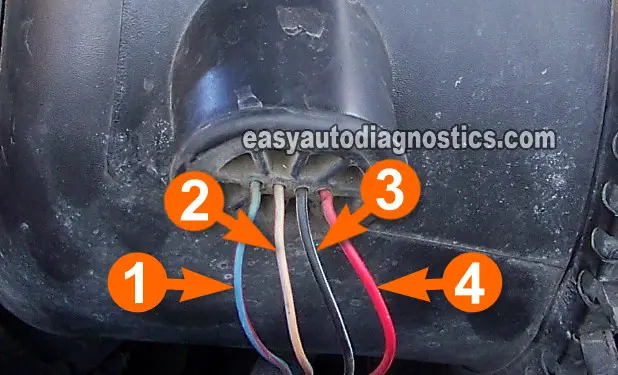TEST 2: Testing The Power (12 V) Circuit

The MAF sensor needs 10 to 12 Volts to function and in this test section, we'll make sure it's getting them.
When performing this test, don't disconnect the round air filter canister assembly from the air duct that connects it to the intake manifold's throttle body.
These are the test steps:
- 1
Put the multimeter in Volts DC mode.
Don't have a digital multimeter? Need to buy one? Click here to see my recommendations: Buying A Digital Multimeter For Automotive Diagnostic Testing. - 2
With the red multimeter test lead and an appropriate tool, probe the MAF sensor connector's wire labeled with the number 4,as shown in the photo.
- 3
Connect the black multimeter test lead to the battery (-) negative terminal.
- 4
Turn the key to the RUN position but don't crank or start the engine.
- 5
You should see 10 to 12 Volts on the multimeter.
Let's take a look at your test results:
CASE 1: The multimeter registered 10 to 12 Volts. So far so good. Now that you've confirmed that the MAF sensor is getting power your next test is to make sure the MAF is getting a good chassis Ground.
Go to: TEST 3: Testing The Chassis Ground Circuit.
CASE 2: The multimeter DID NOT register 10 to 12 Volts. Double check your multimeter connections and retest.
If your multimeter still does not show 10 to 12 Volts, then the mass air flow (MAF) sensor is not the problem. Without this voltage the MAF sensor will not work. Correcting the cause of this missing voltage will get the MAF sensor working again.
TEST 3: Testing The Chassis Ground Circuit

In the previous test we checked and confirmed that the mass air flow (MAF) sensor is receiving 12 Volts.
Now we'll check that the MAF sensor is getting a good Ground. This Ground is a chassis Ground.
These are the test steps:
- 1
Turn key to the OFF position.
- 2
Place the multimeter in Volts DC mode.
- 3
With the black multimeter test lead and an appropriate tool, probe the MAF sensor connector's wire identified with the number 3, as shown in the photo.
- 4
Connect red lead to the battery positive (+) terminal.
- 5
You should see a voltage of 10 to 12 Volts.
Let's see what your test results mean:
CASE 1: The multimeter registered 10 to 12 Volts. All is good in the neighborhood since this test result tells you that you do have power Ground (chassis Ground).
Your next step is to make sure that the MAF RTN circuit is providing Ground. This is a Ground that's provided to the MAF sensor by the PCM. For this test, go to: TEST 4: Testing The 2nd Ground Circuit.
CASE 2: The multimeter DID NOT register 10 to 12 Volts. Double check your multimeter connections and repeat the test.
If your multimeter still does not register the indicated 12 Volts, then the MAF sensor itself is not the problem. Without a clear path to Ground in this circuit, the MAF sensor will not work. Correcting the cause of this missing path to Ground will get the MAF sensor working again.
TEST 4: Testing The 2nd Ground Circuit

For our last test, we'll check the second Ground Circuit of the MAF sensor (this is known as the MAF RTN circuit).
This Ground is provided by the PCM (Powertrain Control Module=Fuel Injection Computer) internally.
To check for this Ground, we'll repeat the same multimeter voltage test we performed in TEST 3, just on a different circuit.
NOTE: Be careful not to connect this wire to battery voltage (12 Volts), or you'll fry the PCM. The multimeter voltage test I'm suggesting in the test instructions is a safe way to check for the presence of Ground in this wire.
Alright, here are the test steps:
- 1
Turn key to the OFF Position.
- 2
Place the multimeter in Volts DC mode.
- 3
Probe the MAF sensor connector's wire identified with the number 2 as shown in the photo with the black multimeter test lead.
- 4
Connect the red multimeter test lead to the battery positive (+) terminal.
- 5
Turn the ignition switch to the RUN position but don't crank or start the engine.
- 6
You should see a voltage of 10 to 12 Volts.
Let's interpret your test results:
CASE 1: The multimeter registered 10 to 12 Volts. This is the correct test result and it indicates that Ground is present in the wire.
You can conclude that the MAF sensor is bad and needs to be replaced if you have:
- Confirmed that the MAF sensor signal does not increase/decrease as you accelerate/decelerate the engine (TEST 1).
- Confirmed the MAF sensor is getting power (TEST 2).
- Confirmed the MAF sensor is getting chassis Ground (TEST 3).
- Confirmed the MAF sensor is getting sensor Ground from the PCM (this test section).
CASE 2: The multimeter DID NOT register 10 to 12 Volts. The MAF sensor is not the problem. Without a clear path to Ground in this circuit, the MAF sensor will not work.
Correcting the cause of this missing Ground will get the MAF sensor working again.

If this info saved the day, buy me a beer!

